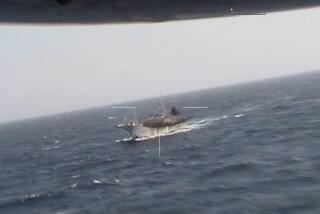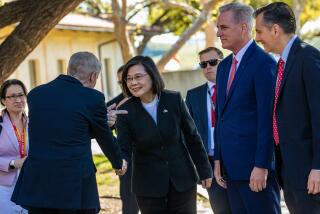Tiny Island of Quemoy Suddenly at Front Line of China-Taiwan Face-Off
QUEMOY, Taiwan — While military aircraft and soldiers mass on China’s craggy coast, just over a mile from this tiny island, Chinese boats are making surreptitious landings on Quemoy’s shores.
They’re not Chinese shock troops. They’re mainland fishermen and smugglers, continuing illicit trade at the height of cross-strait tensions in a small victory of economics over politics. A third of this isolated island’s food, along with other contraband, is secretly brought in from the mainland.
“Every day, we meet the Chinese fishing boats at sea,” said a grizzled fisherman named Chen Kin-du as he loaded his boat’s hold with ice to preserve the day’s catch. “We don’t talk about war. We don’t talk about peace. We just talk about trading.”
But the rest of the world is warily watching this stretch of water--Taiwan’s closest point to the mainland and what suddenly has become the front line in the latest Chinese-Taiwanese confrontation.
On the far side of the Taiwan Strait, Taiwan says, Beijing has assembled 150,000 troops and hundreds of jet fighters for military exercises. The drills, which could begin any day, in all likelihood will include a mock invasion of this island that the Taiwanese govern and China claims as its own.
Cross-strait tensions are simmering as Taiwan readies for its first direct presidential election March 23, a ballot that Beijing fears may mean a shift toward independence. China says it will reclaim Taiwan by force if it must; Washington warns that Beijing had better not. Taiwan’s markets go into a tailspin with every new threat.
The only ones who seem truly calm amid the brewing crisis are the people of Quemoy, or Kinmen, as the islanders call it. They are close enough to see military maneuvers on the other side of the strait--but they also see economic opportunity.
*
“It’s like the eye of a typhoon,” said Tsai Chien-shu, a university lecturer who flew back to his island home for the lunar new year. “People I know in Singapore, Indonesia and America are all worried. But here, we’re too close to China to always think about the threat of war.”
On a rainy afternoon, fishing boats plied the waters calmly under the careful watch of Taiwanese soldiers at the Ma Shan Observation Point. Through their binoculars, the soldiers could clearly see the expressions on the Chinese fishermen’s faces as they pulled in their nets.
“We keep watch and tell the fishing boats not to come too close,” a young soldier said. “If they keep coming, we fire a warning shot. We used to shoot at them, but now we just shoot straight up in the air.” The soldier winced. “We don’t want to start a war here.”
A stray Taiwanese warning shot--or a misfired Chinese test missile--is exactly the kind of explosive accident that has Washington monitoring the strait round-the-clock. Twice before, in 1954 and 1958, Chinese shelling of Quemoy brought the United States to the brink of hostilities with China.
Now, having recognized China instead of Taiwan--though having also pledged to help keep peace between the rival governments--the United States is again on edge.
Some analysts think Beijing’s threats to invade Taiwan are mostly bluster, and U.S. military officials said last week that they saw signs of the Chinese military buildup near the strait abating.
But CIA Director John M. Deutch warned last month: “I am not only concerned about Chinese intentions against Taiwan or some of the smaller Taiwan-held islands in the area, but I’m also very concerned that, in their process of carrying out exercises in the area before the Taiwan elections, that by accident or miscalculation an event occurs that could bring hostilities.”
Quemoy is prepared for any eventuality. Dotting the island are military installations, including an underground hospital and a vast network of tunnels and shelters left over from 1949, when fleeing Nationalist troops held off their Communist pursuers in a bloody battle.
Chinese Communist leader Mao Tse-tung failed twice more to take over Quemoy, the last time after bombarding the coast for a month and a half.
“Because we’ve been through this before, we may sometimes be scared, but we are never panicked,” said Yen Un-wei, a local official. “We’re a very steady people.”
The island’s history of being Taiwan’s “second sea wall,” as a resident wryly dubbed it, has resulted in a certain bravado. On the shelves of local stores, next to herbs and antiques smuggled from China, are Quemoy specialties: butcher knives made from scrap artillery, and sorghum liquor bottled in ceramic decanters shaped like missile launchers.
*
However, in the past peaceful decades, Quemoy has also been on the front lines--albeit illegally--of trade with the mainland. Even when China closed the strait last year during two previous rounds of military exercises, fishermen and traders snuck out for their haul anyway.
Like Quemoy’s persistent cross-channel marketeers, Taiwanese traders upped trade with China 27.5% last year, to almost $20 billion--and this despite mounting political tensions. And Taiwan’s justice minister chose to visit this symbolic island to appeal for direct links with China, though Chinese-Taiwanese talks on the matter have been postponed.
Quemoy officials talk of plans for a “reunification bridge”--an emblematic tie between the island and the nearby Chinese port city of Xiamen.
For now, such contacts remain forbidden. To get to Xiamen--30 minutes by speedboat--Taiwanese travelers officially must fly to Hong Kong, change planes and jet back to Fujian province, an all-day process.
And despite a shortage of fresh water on Quemoy, Taipei won’t let it hook up with China’s pipes, fearing that it would become too dependent on its erstwhile enemy.
But there are still many things shared on both sides of the strait, such as the lunar new year, the most important holiday of the Chinese calendar. Taiwanese military intelligence reported that Beijing postponed its planned war games until early this month so soldiers could enjoy the holiday.
*
In Quemoy too, islanders gathered in front of a temple to light firecrackers, burn money and crash cymbals to scare away evil spirits.
“We’re asking for another year of blessings,” said Lee Dir-ching, a school administrator. “Health and wealth,” he said, and--flinching at the sudden blast of a batch of whistling rockets--he quickly added, “And peace.”
More to Read
Sign up for Essential California
The most important California stories and recommendations in your inbox every morning.
You may occasionally receive promotional content from the Los Angeles Times.










